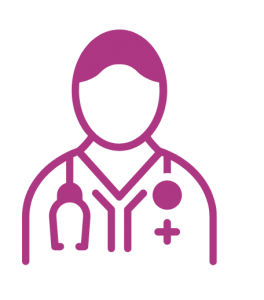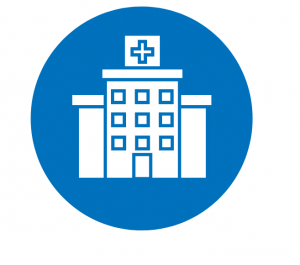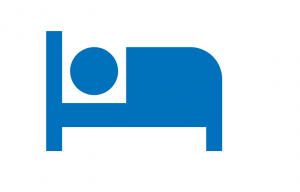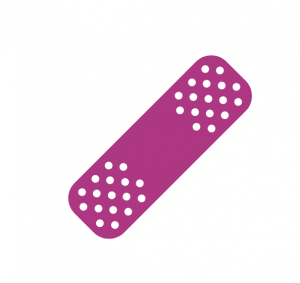
Surgery and recovery
This section provides an overview of treatment options in adulthood, what will happen on the day of surgery, as well as the impact that the recovery may have on your health, work life, financial situation, etc. We would strongly recommend asking questions to the Cleft Team if you are considering further treatment – they are always happy to answer them for you.
“Having a visible difference allows us to be more accepting of others and I know I wouldn’t have overcome some of the hurdles I’ve been faced with if it wasn’t for the processes I’ve been through with my cleft lip.”Roannah, 20
If you’ve had a cleft lip repair, chances are you will have a visible scar that makes you look a little different to other people. You may also have an irregular nose or a ‘flat’ profile, and if you were born with a cleft that affects your gums you may have noticeably irregular teeth. We call this a visible difference. There is no right way to feel about having a visible difference. Some people see it as a fundamental part of who they are and would never want to change it. Others are very self-conscious about it and find it negatively affects their self-esteem. This isn’t necessarily to do with how ‘extreme’ or ‘obvious’ a visible difference is – sometimes, people with quite minor scarring can be the most self-conscious about it, and people with very clear differences can cope exceptionally well.
How You Can Get Help
There are two main treatment options open to adults who are concerned about their appearance:
- Surgical, dental and/or orthodontic treatment which covers both functional and appearance-related concerns
- Therapeutic input from the Cleft Clinical Psychology Team (see ‘Emotional Well-being’)
Surgical Treatment
Treatment options may have changed since the last time you accessed cleft care, and adults with a cleft should always be welcome to have an initial appointment at a Cleft Centre (with a referral from their GP or dentist) to discuss any treatment options that might be open to them. Treatments deemed necessary for issues caused by your cleft should always be free under the NHS, no matter your age.If you’re interested in surgical or dental procedures, you’ll be seen individually with the relevant medical professional to discuss your needs and circumstances. What procedures are appropriate for someone depends on many different factors such as medical history, age, previous surgeries, etc., and a decision about offering further treatment depends on these, not just on the desires of the patient.
Please keep this in mind when thinking about asking for further treatment, and understand that a procedure you want might not be offered to you by the medical team if they do not think it is appropriate.What treatment can I potentially receive as an adult?
There are a number of potential surgical treatment optionsavailable as an adult. Not all options are suitable or available for all people, so talk to your Cleft Team about what treatment may besuitable for you.Some common procedures in adulthood include:
- Fistula repair: repairing any holes left in the roof of yourmouth that can impact on speech, cause food to becomestuck or lead to food and/or fluid coming down your nose.
- Surgery to address speech concerns (e.g. palatelengthening)
- Jaw surgery: major surgery to bring your top and bottomjaws in line with each other. This may be to address concernswith function (i.e. chewing, biting) and/or appearance.
- Rhinoplasty: surgery to change the shape of the nose. This may be to address concerns with breathing and/or appearance.
- Lip revisions: to change the shape of the lip. This may be to address concerns with discomfort (e.g. scar tightness) and/or appearance.
- Lip fillers: to add a substance (e.g. fat) to the lip to give it more fullness
Consult with your Cleft Team about your concerns. They will be able give specific advice on what is available to you.
FAQs
If treatment is available, do I have to have it done?
- Treatment as an adult is optional, so it’s up to you whether to have it or not.
- Talk to trusted family, friends and your Cleft Team about treatment options before you make your decision.
- The psychologist with your Cleft Team can also talk things through with you to help you come to a decision.
Can I change my mind about a treatment plan, dental or surgical procedure?
- Yes, just talk to your Cleft Team about your concerns and they will be able to support you with any changes and arrangements.
- You can also ask to be removed from a waiting list if you are currently waiting for treatment.
- It’s important to be aware that whilst you can stop treatment at any time, very occasionally treatment that you’ve already started cannot be reversed. Make sure you chat to the Cleft Team about what would happen if you stop treatment.
I’m scared of needles, are there other options for anaesthetic?
- If you don’t like needles, let your anaesthetist know before your operation. The best time to let them know is at your pre-admission clinic.
- The team will discuss other options with you. These could include applying EMLA cream to numb your skin prior to injection.
- If your needle phobia is severe, you may be able to have a gas induction instead. During a gas induction, you’ll have a mask placed over your face and asked to breathe in some gas which will send you to sleep. Once you are asleep, the needle will be put in – you won’t see or feel a thing.
- Please don’t be afraid to let them know if you don’t like needles. By letting the team know, they can cater for your needs. The Clinical Psychologist in your team can provide therapy if you have worries related to treatment and think this would be helpful. Your team coordinator can put you in touch.
What happens on the day of surgery?
Every hospital’s procedure will be a little bit different, so it’s worth asking for details at your pre-operative appointment (usually a couple of weeks before your procedure) to get more specific information. Most hospitals will also give you a booklet and other information about what to expect on the day. Have a read through of this booklet as it should answer most of your questions. Generally, the process will be something similar to this:
something similar to this:
- Depending on the instructions on your admissions letter, you will probably not have eaten anything since the night before. You might also not be able to drink anything after a certain time. For your own safety, it’s vital that you follow these instructions exactly, and ask for clarification if you’re not sure.
- On the day, you’ll arrive at the hospital and head to the admissions area indicated on your admissions letter. Here, they will check your name, date of birth, and the reason that you’re in hospital. They may ask you multiple times to confirm this information throughout your stay. This is one of many ways they make sure the correct treatment is given to the correct person. You’ll also be given a bracelet to wear on your wrist which contains your name, address and date of birth. You’ll keep this on throughout your entire stay in hospital.
- Once you’ve been “checked in”, a nurse and/or anaesthetist will check your blood pressure, heart and lungs, etc., to make sure that you’re still fit for the operation. You’ll be asked about any illnesses or injuries you’ve recently had as well as any medicines you may be taking or allergies that you may have. You will also be visited by the surgeon(s) doing your operation to have a chat. This is a great time to ask any final questions before going to theatre, and (if applicable) to let them know if you’d prefer a gas induction to a needle.
- Each surgical theatre has a “list” for the day. This is the order that the operations will happen that day. If you are first on the list,
 you’ll usually be taken to theatre around 8-9am. If you’re further down the list, you may not be taken to theatre until the afternoon. Feel free to ask where you are on the list to give you an idea of when you might go to theatre. You can’t eat or drink before the surgery, and you may be waiting a while, so take a book or something else to keep you occupied while you wait. Note that while you may be told how long your operation is likely to take, the preparation and recovery time involved means you’ll probably be ‘away’ from any friends and family for a while longer. They should provide a contact number so this can be passed on to the ward you’ll be recovering in. Ward staff will call this number when you’re ready for visitors.
you’ll usually be taken to theatre around 8-9am. If you’re further down the list, you may not be taken to theatre until the afternoon. Feel free to ask where you are on the list to give you an idea of when you might go to theatre. You can’t eat or drink before the surgery, and you may be waiting a while, so take a book or something else to keep you occupied while you wait. Note that while you may be told how long your operation is likely to take, the preparation and recovery time involved means you’ll probably be ‘away’ from any friends and family for a while longer. They should provide a contact number so this can be passed on to the ward you’ll be recovering in. Ward staff will call this number when you’re ready for visitors. - At some point, possibly before the nurse and/or anaesthetist checks you over, you will be asked to change into a hospital gown and put compression stockings on your legs. Blankets will be available to keep you warm. Any belongings will usually be put in a plastic bag that can be left with any friends or family, or passed on to the ward in which you will be recovering.
- When it is time for your operation, an orderly will come and collect you to take you to theatre. Any family or friends won’t be able to follow you past this point, so you might want to share a cuddle before you go. Some hospitals will wheel you into theatre on the bed, other hospitals will ask you to walk to theatre if you’re able to do so.
- Once you arrive in theatre, you’ll be asked to lie on the bed. You will have a few sticky pads put onto your chest and abdomen so the anaesthetist can monitor your heart and lungs while you’re asleep. These pads may be cold, but they won’t hurt. They will then clip wires into each of the pads and connect it to a machine. You may also have a leg compression machine placed on your legs if you’re going to have a long operation, or be bedbound for a while afterwards. This machine will help to stop blood clots from developing in your legs. Once you’re ready to be put to sleep, the anaesthetist will talk to you and start the process usually by placing a needle (cannula) in your hand or arm, or sometimes by getting you to breathe in some halothane gas.
- The next thing you know, you will wake up in the recovery ward. It may feel a bit disorientating at first, but a nurse will be right there monitoring you the whole time, so you can be assured you’re in safe hands! Sometimes during long operations, the doctors
 need to insert a catheter, which is a tube that runs into your bladder and allows it to empty without you having to go to the bathroom. This will be removed once you are able to walk around. You’ll be kept on the recovery ward for a little while until the anaesthetic wears off and you can be wheeled back up to the ward. Once back in the ward, you’ll be reunited with any family and friends.
need to insert a catheter, which is a tube that runs into your bladder and allows it to empty without you having to go to the bathroom. This will be removed once you are able to walk around. You’ll be kept on the recovery ward for a little while until the anaesthetic wears off and you can be wheeled back up to the ward. Once back in the ward, you’ll be reunited with any family and friends. - How long you have to stay on the ward is something your team will let you know about. You may be out on the same day, or have to stay a night or two depending on the treatment you have and how your recovery goes.
Some procedures, such as some lip revisions, do not require a general anaesthetic (which puts you to sleep), but are instead done using local anaesthetic (which numbs your feeling in the area while you’re awake). The Cleft Team will let you know what kind of anaesthetic you will have.
Will I be able to eat and drink normally after an operation or dental procedure?
- This will depend on the procedure(s) you have, and it is very important to ask your Cleft Team this. Some treatments have very strict dietary requirements afterwards (e.g. a soft/sloppy diet for some weeks after surgery), whilst others have no particular restrictions for eating afterwards. However, even with no restrictions, people often find that factors such as discomfort following surgery or nausea following anaesthetic alter their appetite for a little while after surgery.
- As well as requiring only certain types of food, some procedures may require you to eat and drink using a plastic syringe, a teaspoon or a straw. This is due to any facial swelling you may have, as well as to protect the surgical site(s) in your mouth, which will often have stitches.
- As swelling reduces and you start to heal, you should be able to drink from a cup and eat with a dessert spoon.
How long will it take me to recover?
- This will depend on the operation, so it is best to ask your Cleft Team what to expect in your case. Everyone heals at different rates, so this may vary for you.
- Bruising (e.g. dark bruises under the eyes if you have had a rhinoplasty) can take a few weeks to settle down. Most swelling will go down in the first week or two, but don’t be too surprised if it takes a few months for all of the swelling to completely disappear. Some procedures are not thought to have reached the ‘final’ result until a year afterwards.

- You may also be expected to wear bandages or other dressings for some time.
- If you have any concerns about coping with these visible aspects after surgery, you might find it helpful to talk to the Cleft Team Clinical Psychologist about how to manage this.
- Some procedures may result in soreness, tenderness or discomfort. You will be given advice on pain relief.
- Recovery from the anaesthetic and other medications can take some time too and may make you feel very sleepy in the meantime. You may also experience short-term side effects like nausea and constipation.
How much time off work/study/leisure activities will I need?
- This will depend on the type of work and activities you do and the treatment you have had. You will need to speak to your Cleft Team for more advice on this, however you would generally expect to be back to work/study/activities sooner if what you do is not so physically demanding (e.g. working in an office).
- Having time off work as an adult can have a financial impact. Make sure to talk to your Cleft Team about this before your operation. The doctors at the hospital will be able to give you a doctor’s note to show to your employer.
I was born with an isolated cleft palate, am I eligible for surgery to change the shape of my nose (rhinoplasty) too?
- You can only access treatment from the Cleft Team that is specifically related to your cleft type. As an isolated cleft palate does not affect the shape of the nose, you would not be eligible for a rhinoplasty.
- You would, however, be eligible for treatment for concerns arising from a cleft palate.
What support and follow up is available after surgery?
- This will vary depending on the procedure and on the team/consultant’s practices. At your consultation before the surgery, make sure to ask what to expect after surgery. For example, if you need to come back in to have stitches removed, or what to do if you experience excessive bleeding, etc.
- If you’re having surgery done privately, make sure to have a look at our ‘Considerations for Private and Non Cleft Team Treatment’ document in the Leaver’s Pack, as there are a few extra things to consider.
Further Support:
Changing Faces
Changing Faces is an organisation which supports and represents people who have conditions or injuries which affect their appearance. They offer a range of services, including support groups, self-help resources and Skin Camouflage clinics where you can learn to apply special cover creams and powders.
Peer Supporters are adults with a cleft who are trained by CLAPA to support others one-on-one over the phone or email. If you’re considering further treatment and want to talk to someone about it, get in touch with CLAPA so we can link you up with a Peer Supporter.
Our Facebook Group for adults with a cleft has almost a thousand members and is growing all the time. Here you can find others like you to share stories and experiences.